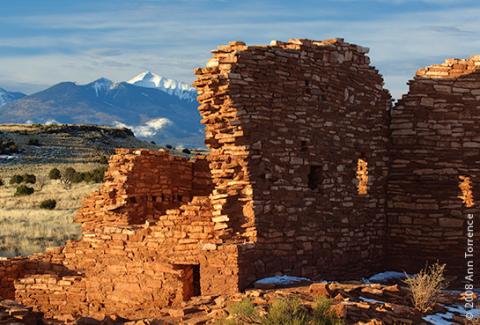In the quiet winter season, the wind rustling among the ruins of Wupatki National Monument whispers like the ancestral voices of its long-departed inhabitants. But around AD 1200, the villages in this corner of the Colorado Plateau would have echoed with the cries of children hauling water in their mothers' hand-made clay vessels, the rhythmic beats of wood-chopping and corn-grinding, the bustle of readying an expedition to harvest pinon nuts, or cheers from a crowd at a meso-American style ballcourt.
Wupatki's artifacts place it at a cultural crossroads of three distinct sub-groups of Ancestral Puebloan peoples: Sinagua, Cohonina and Kayenta Anasazi. The 175 villages and homesites comprising Wupatki National Monument formed an important regional trade center.
At its peak, the surrounding area supported several thousand people within a day's walk of the largest pueblo, also known as Wupatki. The Puebloans grew corn and squash, supplementing their diet with game and the seasonal harvest of pinon nuts found nearby at higher altitudes.
While cliff dwellings are better known (and good examples can be seen at nearby Walnut Canyon National Monmument), free-standing structures such as those found at Wupatki were more commonly built by the Ancient Puebloan peoples. The larger compounds were often three stories high and typically included storage rooms, living areas and underground religious sites known as kivas.
Wupatki is the northernmost of several monuments created in Arizona to preserve pueblo-style structures and their artifacts from the predations of amateur archaeologists and profiteering pot-hunters. The original 1924 declaration included only 800 acres; in 1937 it was enlarged to its present size of 30,000 acres. The contiguous Sunset Crater Volcanic National Monument was established in 1930 after Hollywood movie makers had planned to dynamite the red and orange cinder cone to create a landslide for the movie Avalanche.
Both archaeologists and park visitors find Wupatki of particular interest because its history can be directly tied to the emergence of Sunset Crater. Beginning around AD 1040, the youngest member in the San Francisco Volcanic Field began to erupt, its lava flows and voluminous ash flows overrunning the nearby fields and dwellings, displacing the inhabitants to areas like Wupatki and Walnut Canyon.
Further away from the crater, the ash from Sunset Crater may have enriched the Sinaguan croplands sufficiently to support the region's growing population. Other scientists have speculated that the plume, visible from mountain peaks as far away as Durango, Colorado, and Palm Springs, California, would have drawn people from across a broad region.
Wupatki's habitations appear to have expanded for several generations, with the third and final growth spurt (dated by tree-ring analysis) in about AD 1190.
The Wupatki site and other ruins were partially restored by Hopi masons in 1933, under the direction of a Northern Arizona University archeology professor. Five pueblos are accessible to visitors via the Sunset-Crater-Wupatki loop road that connects both monuments to U.S. Highway 89. Visitors beginning a tour from either Flagstaff or the eastern entrance to Grand Canyon National Park can tour both monuments in a half day.
Each pueblo has a different character, from the hilltop Citadel, where many more habitations that are closed to the public can be spotted, to the Box Canyon ruins, which were built hugging a deep arroyo. A panoramic view of the Painted Desert unfolds from the upper levels of the Wuwoki site. Visitors can explore these ruins at their own pace on well-marked, short trails.
Beginning at the monument's Visitors Center, a paved walking trail winds around the main Wupatki pueblo ruins. The loop also leads to two of the monument's more unusual features. At the geological blowhole, a current of air rushes through a natural aperture in the ground in response to changes in air temperature and atmospheric pressure. Just yards away sits one of the northernmost examples of a meso-American style ballcourt, a linkage, along with trade goods like parrots, shell beads and turquoise, to an expansive trade network connecting the Puebloans to Mexico and Central American cultures.
For reasons that remain a mystery to modern scientists, by AD 1300 the Sinaguans abandoned their Wupatki dwellings. Archaeologists have suggested drought, warfare, or a religious exodus to explain the departure from the area's pueblos. Native tradition holds that at least some of the Sinaguans migrated to larger pueblos to the east, revered today by their descendents in several Hopi clans.
From Flagstaff, take U.S. 89 north 12 miles to the turn-off for the Sunset Crater - Wupatki Loop road. Wupatki National Monument's trails and roads are open year-round from sunrise to sunset. The visitor center is closed Christmas Day.




Add comment